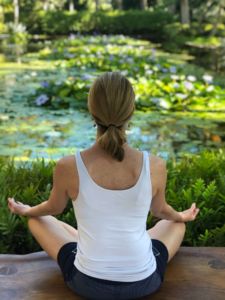Exercise improves your fitness and mood, which benefits your overall health and well-being. Thankfully, you don’t have to go for a strenuous run or a 15-mile bike ride to put in a good workout and boost your morale. Before you lace up your sneakers, consider rolling out a yoga mat instead.
Health Benefits of Yoga and Meditation
Yoga and meditation are both practices that can adapt to a variety of fitness levels. Beginner yogis don’t need to be intimidated by difficult poses, like Lotus or Peacock. The ability to modify and slowly introduce harder poses makes yoga a great addition to any fitness routine. After working on foundational poses, like Downward-Facing Dog and Child’s Pose, you can incorporate more advanced exercises as you build strength and flexibility.
Repeated breath and body exercises simultaneously strengthen your mind and your muscles. The National Center for Complementary and Integrative Health suggests that meditation helps alleviate health problems, encourages healthy habits, and even physically changes the brain and body in beneficial ways. And Dr. Natalie Nevins, an osteopath, speaks to the many benefits of yoga. “Regular yoga practice,” she says, “creates mental clarity and calmness; increases body awareness; relieves chronic stress patterns; relaxes the mind; centers attention; and sharpens concentration.”

Consistently practicing yoga can:
- Improve flexibility
- Strengthen and tone muscles
- Improve cardiovascular health
- Increase mindfulness
- Improve mental health
Combining meditation and yoga as part of a daily routine leads to significant mental and physical benefits. In fact, researchers have found that, overall, those who practice yoga have lower body mass indexes (BMIs) compared to those who do not, no matter their fitness level. People who practiced yoga for at least 30 minutes once a week over the course of four years gained less weight in middle adulthood. And, people who were overweight were able to lose weight.
In addition to the range of health benefits, these practices can fit easily into the busiest schedules. Forget about waking up for a 5:15 a.m. class and rushing to squeeze in a shower before you head to work. Creating a peaceful place to practice yoga and meditation at home is simple. So, where do you start?
How to Create Your Own Yoga & Meditation Space
We’re not talking about a giant studio or an elaborate arrangement of equipment. Your perfect oasis can be located anywhere in your home, and there are just six easy steps to create it.
1. Choose a quiet, low-traffic area in your home
This area doesn’t have to be an entire room. Instead, it could be that small alcove that you never quite know what to do with, dead space at the end of one of your hallways or a cozy corner of a room. Even if you live in a smaller apartment or home, you can still create a serene space for healthy mindfulness.

2. Declutter
The room or space should only have yoga and meditation essentials (we’ve included your list of must-haves in the next section). Letting distractions, like teetering piles of bills or paperwork encroach on your home yoga and meditation room can disrupt your focus and provide a constant reminder of ever-present responsibilities. Physically clearing the space simultaneously unblocks your mind and facilitates a place for much needed respite.
3. Choose purposeful lighting and soothing décor
Your at-home yoga room should be an environment that you look forward to entering. What makes you feel most relaxed? Decorate with inspirational quotes, artwork and symbols that encourage spirituality (whatever that means to you). By adding some of your favorite plants, textures, colors and natural lighting, you can design a much more personalized experience than a generic exercise studio.
4. Take it outside
In the warmer months, head out on your deck or lawn and let the outdoors create the inspiration and ambiance you crave. For those who feel especially grounded in nature, this could help build a more spiritual connection with your time practicing yoga poses or meditating. If you live in a particularly quiet, rural area, meditating amid the sound of the trees or wind adds a peaceful element.
5. Outline your yoga/meditation schedule
Whether or not yoga and meditation are your primary form of exercise and relaxation, make sure that you block the time for yourself. Dedicate time to your practice by setting your alarm clock a little earlier, entering a standing appointment in your phone’s calendar, relying on a paper calendar or a combination of all three.
As you begin, make sure to set some goals for yourself. Do you have a new pose you want to work up to mastering? Do you want to spend a certain amount of time meditating each week? Hold yourself accountable and write down each goal. You may wish to purchase a small journal or planner to keep track of these milestones. Then, as your mind and body become stronger, you can track your progress and take a look at how far you’ve come.
6. Start enjoying the benefits of your new practice
Finally, now that you’ve created a designated place for yoga and meditation at home, use the time in your schedule to enjoy it!
Yoga & Meditation Equipment, Tools and Accessories
At a loss for how to properly furnish your space? This list covers 10 different pieces of equipment to help you meet your yoga and meditation goals.
1. Yoga mat
You can purchase yoga mats in a variety of colors and materials. Consider the flooring of your space when making your purchase. For example, if the floor is particularly slippery, it might be worth investing in a non-slip mat. To find the right option for you, check out the best yoga mats of 2020.
2. Blocks
Yoga blocks are made of foam, bamboo, wood or cork and they help provide balance, support and “raise the floor,” or add length for people with limited range of motion.
3. Bolsters
These thick pillows are filled with various materials. Their firmness and support help with body alignment, enabling users to sink deeper into each pose and more easily transition to the next one.
4. Yoga strap
This tool helps improve flexibility by stretching tight muscles and correctly controlling poses. For purchasing tips, check out this year’s top seven yoga straps.
5. Yoga blankets
Yoga blankets keep you warm during meditation and can help cushion different parts of your body, like your knees, during yoga poses. You can even use a yoga blanket as additional physical support for different exercises.
6. Meditation cushion/floor pillow
The benefit of using a meditation cushion is the body position it encourages. Sitting on a pillow or cushion lifts your hips and brings them forward, which helps the natural curve of your lower back. Once you achieve proper alignment in your spine, the rest of your body can follow suit.
7. Candles or oil diffuser
To create the right ambiance, choose scents and essential oils that you enjoy, or ones that promote relaxation, like lavender. These provide another personal, calming element to your at-home yoga and meditation space.

8. Mala beads
Mala beads are tactile and provide a point of focus and encourage intention. When you practice meditation, you can hold them during your mantra and use each bead to help with repetitions and time.
9. Speakers or a screen for guided classes
If you plan to take advantage of online classes or virtual yoga (we’ve compiled a great bonus list below), you may wish to mount a screen or speakers if your space is more permanent. Alternatively, you can work from a laptop or tablet.
10. Optional: altar
One of the benefits of your at-home studio is that you can also create this small, sacred point of reference. “Puja” is the act of worship involving a strong visual. The idea here is to create something special on which to focus your energy. Whether it’s a deity, an inspiring quote, a salt lamp, photos of loved ones or a family heirloom, if it makes you feel centered, it’s the right piece to enhance your mindfulness exercise.
[BONUS] Virtual Yoga Classes & Meditation Programs to Consider
Now that you’ve created your yoga and meditation room, you might want some direction and support. Here is a list of virtual classes and meditation programs to help guide you on your wellness journey. Namaste!
Yoga
Meditation

